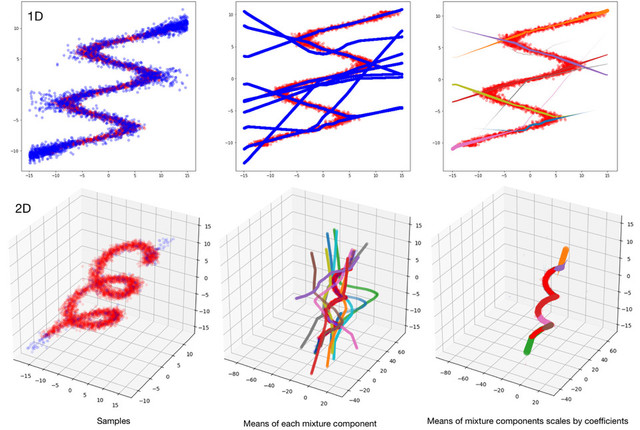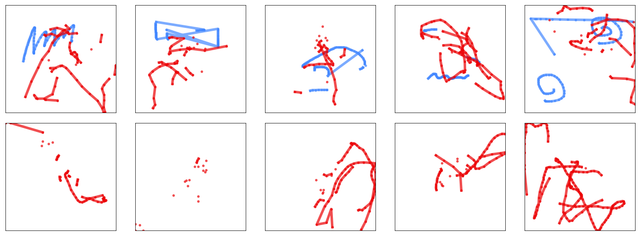An MDN Layer for Keras using TensorFlow's distributions module
Project description
Keras Mixture Density Network Layer
A mixture density network (MDN) Layer for Keras using TensorFlow's distributions module. This makes it a bit more simple to experiment with neural networks that predict multiple real-valued variables that can take on multiple equally likely values.
This layer can help build MDN-RNNs similar to those used in RoboJam, Sketch-RNN, handwriting generation, and maybe even world models. You can do a lot of cool stuff with MDNs!
One benefit of this implementation is that you can predict any number of real-values. TensorFlow's Mixture, Categorical, and MultivariateNormalDiag distribution functions are used to generate the loss function (the probability density function of a mixture of multivariate normal distributions with a diagonal covariance matrix). In previous work, the loss function has often been specified by hand which is fine for 1D or 2D prediction, but becomes a bit more annoying after that.
Two important functions are provided for training and prediction:
get_mixture_loss_func(output_dim, num_mixtures): This function generates a loss function with the correct output dimensiona and number of mixtures.sample_from_output(params, output_dim, num_mixtures, temp=1.0): This functions samples from the mixture distribution output by the model.
Installation
This project requires Python 3.6+, TensorFlow and TensorFlow Probability. You can easily install this package from PyPI via pip like so:
python3 -m pip install keras-mdn-layer
And finally, import the module in Python: import keras_mdn_layer as mdn
Alternatively, you can clone or download this repository and then install via python setup.py install, or copy the mdn folder into your own project.
Examples
Some examples are provided in the notebooks directory.
There's scripts for fitting multivalued functions, a standard MDN toy problem:

There's also a script for generating fake kanji characters:

And finally, for learning how to generate musical touch-screen performances with a temporal component:

How to use
The MDN layer should be the last in your network and you should use get_mixture_loss_func to generate a loss function. Here's an example of a simple network with one Dense layer followed by the MDN.
from tensorflow import keras
import keras_mdn_layer as mdn
N_HIDDEN = 15 # number of hidden units in the Dense layer
N_MIXES = 10 # number of mixture components
OUTPUT_DIMS = 2 # number of real-values predicted by each mixture component
model = keras.Sequential()
model.add(keras.layers.Dense(N_HIDDEN, batch_input_shape=(None, 1), activation='relu'))
model.add(mdn.MDN(OUTPUT_DIMS, N_MIXES))
model.compile(loss=mdn.get_mixture_loss_func(OUTPUT_DIMS,N_MIXES), optimizer=keras.optimizers.Adam())
model.summary()
Fit as normal:
history = model.fit(x=x_train, y=y_train)
The predictions from the network are parameters of the mixture models, so you have to apply the sample_from_output function to generate samples.
y_test = model.predict(x_test)
y_samples = np.apply_along_axis(sample_from_output, 1, y_test, OUTPUT_DIMS, N_MIXES, temp=1.0)
See the notebooks directory for examples in jupyter notebooks!
Load/Save Model
Saving models is straight forward:
model.save('test_save.h5')
But loading requires cutom_objects to be filled with the MDN layer, and a loss function with the appropriate parameters:
m_2 = keras.models.load_model('test_save.h5', custom_objects={'MDN': mdn.MDN, 'mdn_loss_func': mdn.get_mixture_loss_func(1, N_MIXES)})
Acknowledgements
- Hat tip to Omimo's Keras MDN layer for a starting point for this code.
- Super hat tip to hardmaru's MDN explanation, projects, and good ideas for sampling functions etc.
- Many good ideas from Axel Brando's Master's Thesis
- Mixture Density Networks in Edward tutorial.
References
- Christopher M. Bishop. 1994. Mixture Density Networks. Technical Report NCRG/94/004. Neural Computing Research Group, Aston University. http://publications.aston.ac.uk/373/
- Axel Brando. 2017. Mixture Density Networks (MDN) for distribution and uncertainty estimation. Master’s thesis. Universitat Politècnica de Catalunya.
- A. Graves. 2013. Generating Sequences With Recurrent Neural Networks. ArXiv e-prints (Aug. 2013). https://arxiv.org/abs/1308.0850
- David Ha and Douglas Eck. 2017. A Neural Representation of Sketch Drawings. ArXiv e-prints (April 2017). https://arxiv.org/abs/1704.03477
- Charles P. Martin and Jim Torresen. 2018. RoboJam: A Musical Mixture Density Network for Collaborative Touchscreen Interaction. In Evolutionary and Biologically Inspired Music, Sound, Art and Design: EvoMUSART ’18, A. Liapis et al. (Ed.). Lecture Notes in Computer Science, Vol. 10783. Springer International Publishing. DOI:10.1007/9778-3-319-77583-8_11
Project details
Download files
Download the file for your platform. If you're not sure which to choose, learn more about installing packages.
Source Distribution
Built Distribution
File details
Details for the file keras_mdn_layer-0.4.0.tar.gz.
File metadata
- Download URL: keras_mdn_layer-0.4.0.tar.gz
- Upload date:
- Size: 7.4 kB
- Tags: Source
- Uploaded using Trusted Publishing? No
- Uploaded via: poetry/1.8.2 CPython/3.11.3 Darwin/23.4.0
File hashes
| Algorithm | Hash digest | |
|---|---|---|
| SHA256 | 03009d7631ee9d596087627b67a8aab68c5914934c6ab3652f01bbc18abfd8fb |
|
| MD5 | 70c443fc997e935c2ff8bd6420bf6e98 |
|
| BLAKE2b-256 | 3dc4ba674f6dd407ae47f2a823ed7b1e8a7601f4b9b9c5f6b0822259f3b524fd |
File details
Details for the file keras_mdn_layer-0.4.0-py3-none-any.whl.
File metadata
- Download URL: keras_mdn_layer-0.4.0-py3-none-any.whl
- Upload date:
- Size: 8.7 kB
- Tags: Python 3
- Uploaded using Trusted Publishing? No
- Uploaded via: poetry/1.8.2 CPython/3.11.3 Darwin/23.4.0
File hashes
| Algorithm | Hash digest | |
|---|---|---|
| SHA256 | 983a553bb7ef600a6df076f97727a4fdaa861653ff44ada76259525a5483b9bd |
|
| MD5 | 30b5b8c66c54e9687676bc34d2bf8135 |
|
| BLAKE2b-256 | 043debe868cde0b0377321ae04449a8f7b38f5d088a9fb2dd34aee9fc3483acc |















